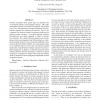2047 search results - page 175 / 410 » The limits of speech recognition |
ICASSP
2011
IEEE
13 years 1 months ago
2011
IEEE
Neurophysiological studies in the primary auditory cortex have recently demonstrated a rich diversity of responses that provide an explicit multidimensional representation of phon...
NOLISP
2005
Springer
14 years 3 months ago
2005
Springer
The best performing systems in the area of automatic speaker recognition have focused on using short-term, low-level acoustic information, such as sepstral features. Recently, vari...
ICASSP
2011
IEEE
13 years 1 months ago
2011
IEEE
Emotion recognition from speech plays an important role in developing affective and intelligent systems. This study investigates sentence-level emotion recognition. We propose to ...
SMC
2007
IEEE
14 years 4 months ago
2007
IEEE
— The focus of this paper is mental tension detection in speech to assist control the tension in day-to-day business such as conferences and operations in a call center. It is di...
ISCAS
2003
IEEE
14 years 3 months ago
2003
IEEE
The most popular speech feature extractor used in automatic speech recognition (ASR) systems today is the mel frequency cepstral coefficient (mfcc) algorithm. Introduced in 1980,...

